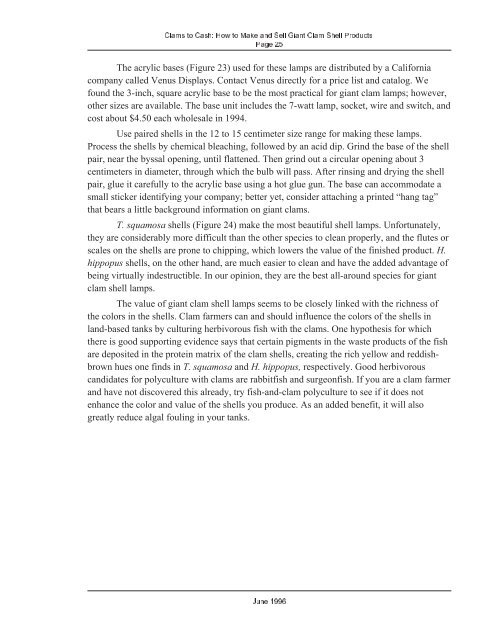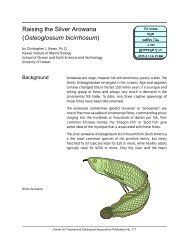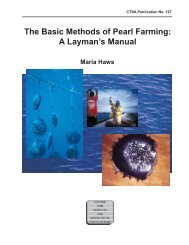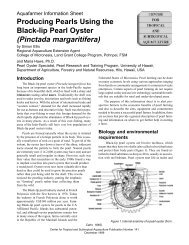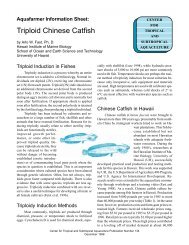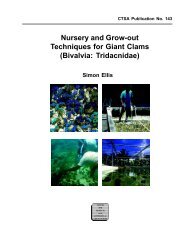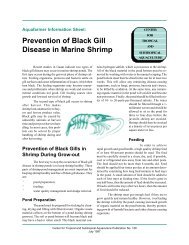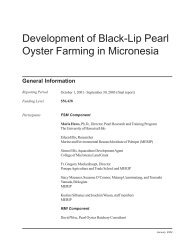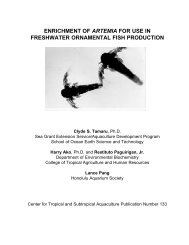Clams to Cash: How to Make and Sell Giant Clam Shell ... - eXtension
Clams to Cash: How to Make and Sell Giant Clam Shell ... - eXtension
Clams to Cash: How to Make and Sell Giant Clam Shell ... - eXtension
- No tags were found...
Create successful ePaper yourself
Turn your PDF publications into a flip-book with our unique Google optimized e-Paper software.
<strong><strong>Clam</strong>s</strong> <strong>to</strong> <strong>Cash</strong>: <strong>How</strong> <strong>to</strong> <strong>Make</strong> <strong>and</strong> <strong>Sell</strong> <strong>Giant</strong> <strong>Clam</strong> <strong>Shell</strong> ProductsPage 25The acrylic bases (Figure 23) used for these lamps are distributed by a Californiacompany called Venus Displays. Contact Venus directly for a price list <strong>and</strong> catalog. Wefound the 3-inch, square acrylic base <strong>to</strong> be the most practical for giant clam lamps; however,other sizes are available. The base unit includes the 7-watt lamp, socket, wire <strong>and</strong> switch, <strong>and</strong>cost about $4.50 each wholesale in 1994.Use paired shells in the 12 <strong>to</strong> 15 centimeter size range for making these lamps.Process the shells by chemical bleaching, followed by an acid dip. Grind the base of the shellpair, near the byssal opening, until flattened. Then grind out a circular opening about 3centimeters in diameter, through which the bulb will pass. After rinsing <strong>and</strong> drying the shellpair, glue it carefully <strong>to</strong> the acrylic base using a hot glue gun. The base can accommodate asmall sticker identifying your company; better yet, consider attaching a printed “hang tag”that bears a little background information on giant clams.T. squamosa shells (Figure 24) make the most beautiful shell lamps. Unfortunately,they are considerably more difficult than the other species <strong>to</strong> clean properly, <strong>and</strong> the flutes orscales on the shells are prone <strong>to</strong> chipping, which lowers the value of the finished product. H.hippopus shells, on the other h<strong>and</strong>, are much easier <strong>to</strong> clean <strong>and</strong> have the added advantage ofbeing virtually indestructible. In our opinion, they are the best all-around species for giantclam shell lamps.The value of giant clam shell lamps seems <strong>to</strong> be closely linked with the richness ofthe colors in the shells. <strong>Clam</strong> farmers can <strong>and</strong> should influence the colors of the shells inl<strong>and</strong>-based tanks by culturing herbivorous fish with the clams. One hypothesis for whichthere is good supporting evidence says that certain pigments in the waste products of the fishare deposited in the protein matrix of the clam shells, creating the rich yellow <strong>and</strong> reddishbrownhues one finds in T. squamosa <strong>and</strong> H. hippopus, respectively. Good herbivorousc<strong>and</strong>idates for polyculture with clams are rabbitfish <strong>and</strong> surgeonfish. If you are a clam farmer<strong>and</strong> have not discovered this already, try fish-<strong>and</strong>-clam polyculture <strong>to</strong> see if it does notenhance the color <strong>and</strong> value of the shells you produce. As an added benefit, it will alsogreatly reduce algal fouling in your tanks.June 1996


